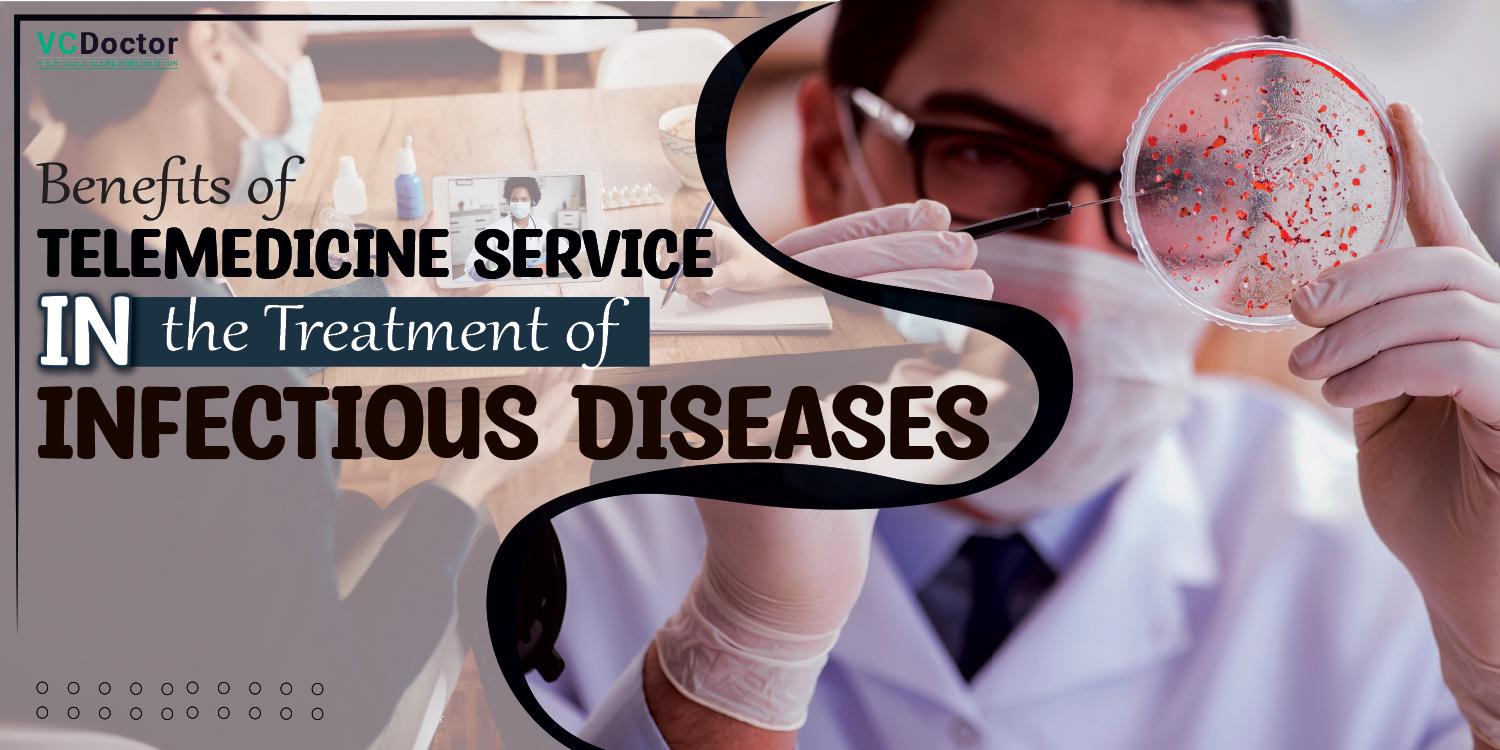Benefits of Telemedicine Service in the Treatment of Infectious Diseases
Numerous medical diseases have been identified where telemedicine has been used. Telemedicine service can enhance patient care, lower geographic barriers, and improve access to care. Telemedicine’s function in antimicrobial stewardship programs for treating acute and chronic infectious diseases, such as HIV and hepatitis, has been detailed. This blog aims to provide information on synchronous telemedicine programs to manage infectious diseases.
Through telehealth and telemedicine, the ongoing development of technology offers chances to create, enhance, and extend access to healthcare for various groups. Telemedicine service is explained by the World Health Organization (WHO) as
“the delivery of health care services, where distance is a critical factor, by all health care professionals using information and communication technologies for the exchange of valid information for the diagnosis, treatment, and prevention of disease and injuries, research and evaluation, and for the continuing education of healthcare providers, all in the interests of advancing the health of individuals and their families.”
Although “telehealth” and “telemedicine” are sometimes used synonymously, telehealth refers to “a broad breadth of remote healthcare services,” whereas “telemedicine” is primarily the delivery of remote clinical services.
Because telemedicine service is more widely available and accepted by patients and medical professionals in this expanding clinical practice, many advantages have been realized through its utilization. The increasing availability and affordability of equipment, Medicare, and Medicaid reimbursement modifications, and expansion of billing parity regulations are all results of clinical and educational benefits. Further interest in this method of healthcare delivery has been sparked by the potential cost benefits for both patients and healthcare systems.
Intending to increase access to care and clinical results, telemedicine in infectious diseases is a growing clinical practice. Patients with acute infectious diseases and chronic infections, such as HIV and hepatitis C virus (HCV), and those who reside in remote or isolated populations, may not otherwise have access to healthcare without it. Additionally, telehealth may enhance access in situations like pre-exposure prophylaxis (PrEP), which helps prevent HIV.
The Infectious Diseases Society of America (IDSA) is the only infectious illnesses organization with a specific position statement on the use of telehealth and telemedicine, despite the growing practice of telemedicine in infectious diseases.
The expanding number of telemedicine programs used for diagnosing and treating infectious diseases will be examined in this blog.
Checkout the Latest Telemedicine Trends in 2022
Telemedicine has drastically moved forward towards success. You can implement the new upgrades into your existing telemedicine software from here!
Request a QuoteLet’s see some Outcomes of Telemedicine for infectious disease care.
Antimicrobial Stewardship
Additional chances to address worries about rising antibiotic resistance are provided by telemedicine in antimicrobial stewardship. A 220-bed hospital in southern Brazil created a web-based infrastructure to enable fast post-prescription reviews of clinical data and to give doctors input from distant infectious diseases specialists.
After collecting usage data, the initiative boosted the percentage of prescription appropriate antibiotics from 51.4% to 81.4%. The weekly virtual meetings for all inpatient clinical cases in this remote stewardship program were facilitated via real-time online conversations. The medical staff had access to a high-definition camera, microphones, real-time file sharing, desktop sharing, and radiographic pictures.
The hospital conducted a “before and after” research to compare the period before the program’s introduction with the period after it by a year. They discovered a trend in the number of nosocomial infections, the cost of antibiotics, and the typical number of prescriptions written for antibiotics each admission.
Acute Infectious Diseases
When there is a poor access to health care services and treatment by medical professionals with expertise in infectious diseases, infectious diseases can frequently be poorly handled in rural or isolated areas. The IDSA also encourages telemedicine to give people in need of treatment for infectious diseases prompt access.
To manage Staphylococcus aureus bacteremia (SAB), a study was conducted comparing the effectiveness of telemedicine (three times per week) against on-site infectious disease consultation (standard of care [SOC]). There were 163 patients in the telemedicine service intervention group and 583 in the SOC group in this retrospective cohort analysis of adult patients.
There were no disparaties between the groups regarding SAB bundle adherence, 30-day mortality, 30-day SAB-related readmission, persistent bacteremia, or time to culture clearance.
Compared to the rest of Canada, the 32 First Nations communities in the Sioux Lookout region of Ontario, Canada, have a higher incidence and rate of infectious diseases such as tuberculosis, acute rheumatic fever, and skin and soft tissue infections. The Sioux Lookout Meno Ya Win Health Centre, the Sioux Lookout Regional Hospital, and the Division of Infectious Diseases at The Ottawa Hospital in Ontario, Canada, collaborated to create a telemedicine-based consultation program in 2014.
After each patient’s initial video consultation, patient satisfaction surveys for telemedicine delivery were done during the data collection timeframe between July 2014 and July 2015, with an overall patient satisfaction rate of 98%.
Telemedicine programs can link patients in those populations with multidisciplinary infectious diseases specialized teams that can give them the necessary treatment and care to optimize clinical outcomes, which can help with the rising burden of infectious diseases.
Hepatitis
The WHO’s goals of expanding access to care and promoting health services focused on the treatment of hepatitis can be met in large part by telemedicine programs. Hepatitis B and C infect about 325 million people worldwide, according to the WHO. By enhancing hepatitis prevention, testing, treatment, and care services, advocating for universal health coverage of hepatitis services, and strengthening alliances and funding in the battle against hepatitis, the organization hopes to eliminate viral hepatitis worldwide by 2030.
To raise the rate of HCV treatment in prisons in the North-East of England, UK, blood-borne virus testing was made universally available, along with jail telemedicine for clinics. Between August 2015 and October 2017, 80 patients were seen in the telemedicine clinic in one of the jails.
Six people had access to HCV treatment before the telemedicine clinic was established. Anti-HCV treatment was extended to 57 out of the 80 patients seen in the clinic following the establishment of the HCV program. The telemedicine clinic’s patients reported high satisfaction levels (80% outstanding) and decreased prisoner movement costs (estimated at £500 per hospital visit).
HCV viral elimination by 2030 may become a reality because of improved access to HCV therapy made attainable by telemedicine and the availability of direct-acting antivirals and their safety and efficacy.
Human Immunodeficiency Virus
Although improvements in HIV drugs have given individuals choices for treating and preventing the virus, it continues to remain a chronic health concern for many people worldwide. Only 19.5 million of the 36.7 million persons living with HIV in 2016 were receiving treatment, according to the Centers for Disease Control and Prevention (CDC). Populations in remote areas may not access specialized HIV care and treatment.
Patients are flown into Aberdeen for lab work and consultations by the National Health Services (NHS) Grampian in Scotland, which offers HIV care to residents of the Orkney and Shetland islands. The NHS Scotland introduced the “Attend Anywhere” application in 2017, a platform that allowed patients to complete secure video consultations work from home after completing blood work at a general practice on their island at their convenience. The NHS expanded the variety of health treatments and cared available to patients living with HIV in rural locations by adopting the initiative.
Telemedicine programs give patients who might not have otherwise got therapy access to specialized HIV care. Reduced HIV transmission may be achieved due to increased antiviral therapy suppression with the development of safer and simpler antiretroviral regimens and telemedicine to manage this chronic illness.
Pre-Exposure Prophylaxis
Patients who are getting the treatment have experienced a variety of difficulties obtaining and maintaining access to PrEP. For instance, barriers to treatment include stigma, expense, adherence to medicine, and scheduling sessions with a doctor. A study conducted in San Francisco, California, USA, on 25 young males who have sex with men between the ages group of 18 and 25 assessed the use of free PrEP using telehealth services.
This telemedicine strategy offered free sexually transmitted infection testing kits and home delivery of PrEP for participants. Two physical lab visits were necessary for HIV testing and baseline and 90 days after starting PrEP. Over 180 days, participants were longitudinally tracked. Although there were no cases of HIV found in 21 patients who finished the research, the rates of STD infection remained unchanged. At least 75% of participants said the intervention was private, quick, practical, and simple to apply. Among the subjects, less than 15% reported PrEP stigma.
Among the advantages of a telemedicine service mentioned above increase access to telemedicine technologies, digital health services, virtual care, cost-effectiveness, and a decline in the administration of unnecessary antibiotics. While telemedicine programs have expanded since the early 2000s, their growth has peaked. Acute or chronic infectious diseases frequently require treatment and care from professionals with the necessary knowledge and experience, yet many communities have limited access to these professionals.
Want to add HIPAA Compliance to your existing suit?
If yes, then you can connect with us at vcdoctor.com. We provide highly sustainable HIPAA protocols in each of our softwares & applications. Check out now!
Contact UsConclusion
Telemedicine service is a practical choice for delivering healthcare services, treating acute and chronic infectious diseases, and preventing HIV as usage of and improvements in technology rise. This blog highlights the benefits of using telemedicine to treat infectious diseases and the requirement for the ongoing development of such initiatives to increase access to healthcare.




